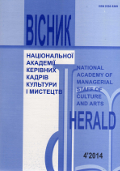ДІЯЛЬНІСТЬ КИЇВСЬКОЇ ЄПАРХІЇ В ПРОСВІТНИЦЬКІЙ СФЕРІ: перша половина XIX ст.
The activity of Kyiv eparchy in the educational sphere: the first half of the XIX century
Author(s): Anna SviatnenkoSubject(s): Christian Theology and Religion, Anthropology, Education, 18th Century, 19th Century
Published by: Національна академія керівних кадрів культури і мистецтв
Keywords: educational activities; Kyiv Diocese clergy; religious educational institutions;
Summary/Abstract: At the end of the XVIII century the imperial authority held the clerical administrative reform. Its result was the creation of practically new Kyiv Diocese. The church hierarchy faced the problem of supply the newly settled diocese of the educated Orthodox clergy.The preparation of the lower clergy and providing primary education for future seminarians began from the establishment of the county and parish school network.The bishops, local clergy were the main initiators of the establishment of new religious schools. Their efforts got great results. The number of religious schools has gradually increased. In 1840 there were 5 country and parish educational institutions in Kiev diocese. During the last decade of that period a network of schools did not change and did not meet the legal norms. According to them, it was allowed to have 30 parochial schools in every diocese, and the number of the country schools had to be equal to the number of county districts.The attention focused on recruitment of students to school. The schools were crowded unequally. The diocesan rulers created the country school district for the balance of the students community. The absence of the habit of the learning and understanding of the advantages of the education made clergy use compulsory measures to attract clergy children to educational institutions.The goal of the primary school was to educate to clergyman and priest children, but the children of civil people such as nobles, officials, merchants and soldiers studied there. Gradually, the access to enter such schools was limited for students by special instructions that were intended to transform schools into closed class ones.The seminary board organized the activity of religious schools. The Reverends played the role of the major car-ers. The supervisors controlled the internal management of the schools. Typically, they were the arch priests and monks of the churches and abbeys, where the schools were situated. They had higher education, were highly moral people with responsible attitude to their duties. Therefore, they had to supply the schools of the pupils and teachers, to settle of school classrooms and provide schools with the necessary equipment, to monitor the progress of students studying and behavior, level of teaching etc.The selection of teachers' staff was conducted carefully. The observers created the detailed lists of candidates for the post of teacher, defining their skills, level of education. These lists were discussed by the school governments, and then were stated by the diocesan board. Analysis of these lists shows a high quality of teachers in primary schools. The tendency of the provision of school teachers with higher academic and seminary education persisted throughout the studied period.The studying sphere of elementary religious schools were regularly checked by the members of the government. The adjustment of the learning process, the senior management ruled with the main task of spiritual institutions – to prepare the Orthodox priests that’s why they prefered the learning of purely religious subjects, division courses for the major and minorDuring the study period the logistics of the clerical education was a constant problem. Despite of it the orphans and the part of poor students were given the opportunity to study at public or half-public expense.So, during the researched period a network of primary schools was created in the Kyiv diocese,. Their main tasks were to prepare competent, ethical individuals, who was worth to represent the Orthodox Church in the lands and to engage the piety local population and at the same time to educate the faithful and obedient "ideologues", followers of imperial policy.However, it should be noted that the effective functioning of religious schools was possible through the efforts of local clergy who initiated the opening of schools, invented the means to maintain them. The Quality selection of teachers and demanding attitude to the success of pupils, the great attention to education in the spirit of Christian morality did well for schools and distinguished them among other schools and made them more attractive for studying.
Journal: Вісник Національної академії керівних кадрів культури і мистецтв
- Issue Year: 2014
- Issue No: 4
- Page Range: 180-186
- Page Count: 7
- Language: Ukrainian

